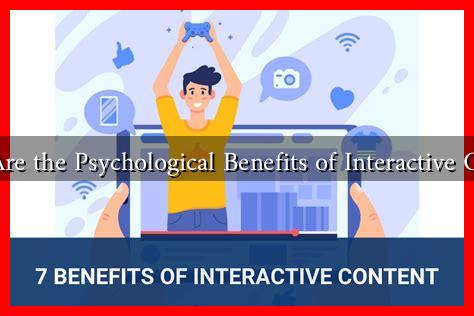-
Table of Contents
What Are the Psychological Benefits of Interactive Content?
In the digital age, content consumption has evolved significantly. Traditional static content, such as articles and images, is increasingly being supplemented or replaced by interactive content. This shift is not merely a trend; it reflects a deeper understanding of how engagement affects learning, retention, and emotional connection. In this article, we will explore the psychological benefits of interactive content and how it can enhance user experience and engagement.
Understanding Interactive Content
Interactive content refers to any type of content that requires active participation from the user. This can include quizzes, polls, interactive infographics, videos, and games. Unlike passive content, where users simply absorb information, interactive content encourages users to engage, think critically, and respond. This engagement can lead to several psychological benefits.
Enhanced Engagement and Attention
One of the most significant psychological benefits of interactive content is its ability to capture and maintain user attention. According to a study by the Content Marketing Institute, interactive content generates 2x more conversions than passive content. This is largely due to the following factors:
- Active Participation: Users are more likely to remember information when they actively engage with it. Interactive content requires users to think, respond, and participate, which enhances cognitive processing.
- Immediate Feedback: Many interactive formats provide instant feedback, allowing users to see the results of their actions. This immediate gratification can reinforce learning and encourage further exploration.
- Personalization: Interactive content often allows for a personalized experience, catering to individual preferences and needs. This tailored approach can make users feel more connected to the content.
Improved Retention and Learning
Interactive content has been shown to improve information retention significantly. A study published in the Journal of Educational Psychology found that students who engaged with interactive learning tools retained 75% of the information, compared to just 20% retention from traditional lectures. The reasons for this enhanced retention include:
- Multi-sensory Learning: Interactive content often engages multiple senses, which can enhance memory. For example, a user who participates in a video quiz is likely to remember the information better than if they had simply watched a video.
- Active Learning: Engaging with content actively rather than passively encourages deeper cognitive processing, leading to better understanding and retention.
- Gamification: Incorporating game-like elements into content can make learning more enjoyable and memorable. For instance, educational platforms like Kahoot! use quizzes to make learning fun and engaging.
Emotional Connection and Brand Loyalty
Interactive content can also foster a stronger emotional connection between users and brands. When users engage with content that resonates with them, they are more likely to develop a sense of loyalty. This emotional connection can be attributed to:
- Storytelling: Interactive content often incorporates storytelling elements, allowing users to immerse themselves in a narrative. This can create a more profound emotional impact.
- Community Building: Interactive formats, such as forums or social media polls, encourage users to share their opinions and experiences, fostering a sense of community.
- Empowerment: By allowing users to make choices and see the outcomes, interactive content empowers them, leading to a more positive association with the brand.
Case Studies and Real-World Examples
Several brands have successfully leveraged interactive content to enhance user engagement and achieve their marketing goals:
- BuzzFeed Quizzes: BuzzFeed’s quizzes are a prime example of interactive content that drives engagement. These quizzes not only entertain but also encourage users to share their results, increasing brand visibility.
- Airbnb’s Interactive Map: Airbnb uses an interactive map that allows users to explore different destinations and accommodations. This engaging tool enhances the user experience and encourages bookings.
- National Geographic’s Interactive Infographics: National Geographic employs interactive infographics to educate users about various topics, making complex information more digestible and engaging.
Conclusion
The psychological benefits of interactive content are profound and multifaceted. By enhancing engagement, improving retention, and fostering emotional connections, interactive content can significantly impact how users interact with information and brands. As digital landscapes continue to evolve, businesses and educators alike should consider incorporating interactive elements into their content strategies to maximize user engagement and satisfaction. For more insights on interactive content, you can explore resources from the Content Marketing Institute.

